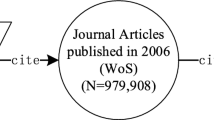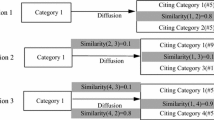Abstract
This article studies interdisciplinarity and the intellectual base of 34 literature journals using citation data from Web of Science. Data from two time periods, 1978–1987 and 1998–2007 were compared to reveal changes in the interdisciplinary citing of monographs. The study extends the analysis to non-source publications; using the classification of monographs to show changes in the intellectual base. There is support for increased interdisciplinary citing of sources, especially to the social sciences, and changes in the intellectual base reflect this. The results are explained using theories on the intellectual and social organization of scientific fields and the use of bibliometric methods on the humanities is discussed. The article demonstrates how citation analysis can provide insights into the communication patterns and intellectual structure of scholarly fields in the arts and humanities.




Similar content being viewed by others
Notes
Journal Info. Lund University Libraries (Sweden). http://jinfo.lub.lu.se/ (2008-04-12).
FRIDA. http://frida.usit.uio.no/ (2008-04-12).
Guidelines. European reference index for the humanities. http://www.esf.org (2009-10-22).
A simple search for Grammatology using Google Scholar resulted in 3680 citing articles. A similar search using Google book search retrieved 1050 references made to Grammatology from monographs (2010-10-5).
The high number of citations to Lenin—nearly as many as to Shakespeare—can be explained by the inclusion of some Soviet journals where references to Lenin were almost mandatory.
References
Al, U., Sahiner, M., & Tonta, Y. (2006). Arts and humanities literature: Bibliometric characteristics of contributions by Turkish authors. Journal of the American Society for Information Science and Technology, 57(8), 1011–1022.
Archambault, E., Vignola-Gagne, E., Côté, G., Lavrivére, V., & Gringras, Y. (2006). Benchmarking scientific output in the social sciences and the humanities: The limits of existing databases. Scientometrics, 68(3), 329–342.
Ardanuy, J., Urbano, C., & Quintana, L. (2009). A citation analysis of Catalan literary studies (1974–2003): Towards a bibliometrics of humanistic studies in minority languages. Scientometrics, 81(2), 347–366.
Åström, F. (2007). Changes in the LIS research Front: Time-sliced cocitation analyses of LIS journal articles, 1990–2004. Journal of the American Association of Information Science and Technology, 58(7), 947–957.
Becher, T., & Trowler, P. R. (2001). Academic tribes and territories: Intellectual enquiry and the culture of disciplines (2nd ed.). Buckingham: The Society for Research into Higher Education & Open University Press.
Bulter, L., & Visser, M. S. (2006). Extending citation analysis to non-source items. Scientometrics, 66(2), 327–343.
Cusset, F. (2008). French Theory: How Foucault, Derrida, Deleuze & Co. Transformed the intellectual life of the United States (Jeff Fort, Trans.). Minneapolis: University of Minnesota Press.
Dowell, E. (1999). Interdisciplinarity and new methodologies in art history: A citation analysis. Art Documentation, 18(1), 14–19.
Evans, C. (1993). English people: The experience of teaching and learning English in British universities. Buckingham: Open University Press.
Evans, J. H. (2005). Stratification in knowledge production: Author prestige and the influence of an American academic debate. Poetics, 33, 111–133.
Finkstaedt, T. (1990). Measuring research performance in the humanities. Scientometrics, 19(4/5), 407–417.
Garfield, E. (1980). Is information retrieval in the arts and humanities inherently different from that in science? The effect that ISI’s citation index for the arts and humanities is expected to have on future scholarship. Library Quarterly, 50(1), 40–57.
Gibbons, M., Limoges, C., Nowotny, H., Schwartzman, S., Scott, P., & Trow, M. (1994). The new production of knowledge: The dynamics of science and research in contemporary societies. London: Sage.
Guillory, J. (1997). Cultural capital: The problem of literary canon formation. Chicago: The University of Chicago Press.
Hellqvist, B. (2010). Referencing in the humanities and its implications for citation analysis. Journal of the American Society for Information Science and Technology, 61(2), 310–318.
Hérubel, J.-P., & Buchanan, A. L. (1994). Citation studies in the humanities and social sciences: A selective and annotated bibliography. Collection Management, 18(3/4), 89–136.
Hérubel, J. P., & Goedeken, E. A. (2001). Using the arts and humanities citation index to identify a community of interdisciplinary historians: An exploratory bibliometric study. The Serials Librarian, 41(1 s.), 85–98.
Klein, J. T. (1996). Crossing boundaries: Knowledge, disciplinarities and interdisciplinarities. Charlottesville: University of Virginia Press.
Lamont, M. (1987). How to become a dominant French philosopher: The case of Jacques Derrida. The American Journal of Sociology, 93(3), 584–622.
Lamont, M. (2000). Meaning-making in cultural sociology: Broadening our agenda. Contemporary Sociology, 29(4), 602–607.
Larivière, V., Archambault, E., Gringas, Y., & Vignola-Gagné, E. (2006). The place of serials in referencing practices: Comparing natural science and engineering with social sciences and the humanities. Journal of the American Association of Information Science and Technology, 57(8), 997–1004.
Leydesdorff, L., & Salah, A. A. A. (2010). Maps on the basis of the Arts & Humanities Citation Index: The journals Leonardo and Art Journal, and “Digital Humanities” as a topic. Journal of the American Society for Information Science and Technology, 61(4), 787–801.
Linman, A. J. M. (2010). Why with bibliometrics the Humanities does not need to be the weakest link: Indicators for research evaluation based on citations, library holdings, and productivity measures. Scientometrics, 83(2), 337–354.
McCain, K. W. (1987). Citation patterns in the history of technology. Library and Information Science Research, 9, 41–59.
Mignolo, W. D. (1991). Canons a(nd) cross-cultural boundaries (Or, whose canon are we talking about?). Poetics Today, 12(1), 1–28.
Milner, A. (1996). Literature, culture and society. London: UCL Press.
Persson, O. (1994). The intellectual base and research fronts of JASIS 1986–1990. Journal of the American Association for Information Science, 45(1), 31–38.
Persson, O., Danell, R. & Schneider, J. W. (2009). How to use Bibexcel for various types of bibliometric analysis. Celebrating Scholarly Communication Studies: A Festschrift for Olle Persson at his 60th Birthday. Ed. Fredrik Åström. Special volume of the e-zine of the ISSI, vol. 05-S June 2009.
Rafols, I., & Leydesdorff, L. (2009). Content based and algorithmic classifications of journals: Perspectives on the dynamics of scientific communications and indexer effects. Journal of the American Society for Information Science and Technology, 60(9), 1823–1835.
Small, H. (2010). Maps of science as interdisciplinary discourse: co-citation contexts and the role of analogy. Scientometrics, 83(3), 835–849.
Sweetland, J. H. (1989). Errors in bibliographic citations: A continuing problem. Library Quarterly, 59(4), 291–304.
Van Raan, A. (2004). Sleeping beauties in science. Scientometrics, 59(3), 467–472.
Weingart, P. (1997). From “finalization” to “Mode 2”: Old wine in new bottles? Social Science Information, 36, 591–613.
Weintraub, K. J. (1980). The humanistic scholar and the library. Library Quarterly, 50(1), 22–39.
Whitley, R. (1984). The intellectual and social organization of the sciences. Oxford: Clarendon Press.
Acknowledgments
The author wishes to thank Kerstin Rydbeck and Fredrik Åström as well as the anonymous reviewers for valuable comments and suggestions.
Author information
Authors and Affiliations
Corresponding author
Rights and permissions
About this article
Cite this article
Hammarfelt, B. Interdisciplinarity and the intellectual base of literature studies: citation analysis of highly cited monographs. Scientometrics 86, 705–725 (2011). https://doi.org/10.1007/s11192-010-0314-5
Received:
Published:
Issue Date:
DOI: https://doi.org/10.1007/s11192-010-0314-5




